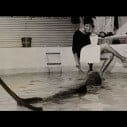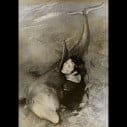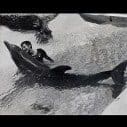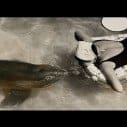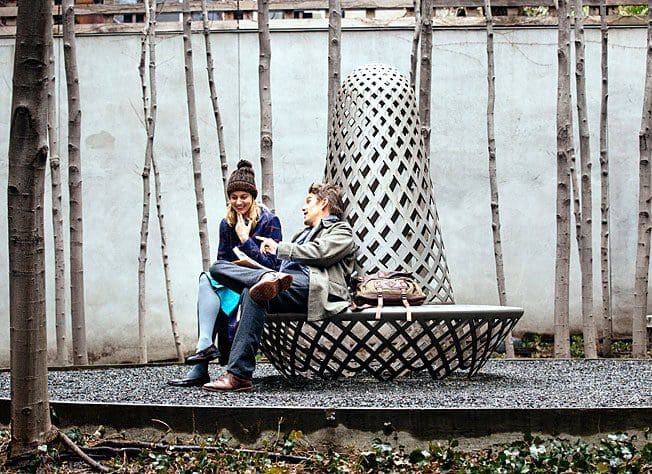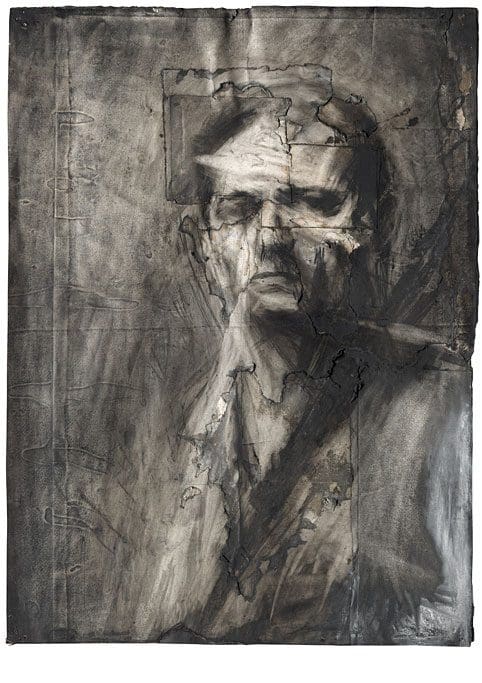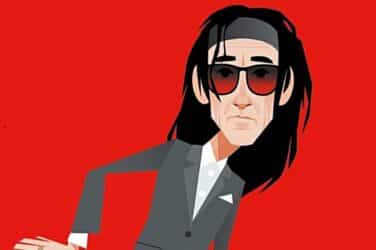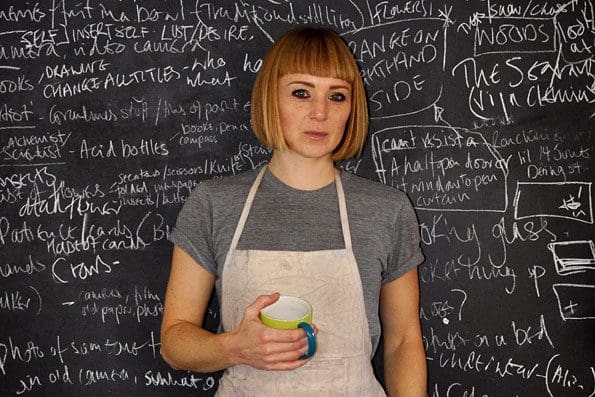BBC Four is set to journey back to the 1960s and uncover the story of a remarkable experiment that helped to define the 1960s as the decade of big ideas.
Scientist John Lilly had the revolutionary idea “to create a bi-species society where humans would not only communicate with one another to shape ideas”, explains Christopher Riley director of The Girl Who Talked to Dolphins.
The story revolves largely around Margaret Howe, one of Lilly’s assistants who forged a remarkable connection with the Dolphin named Peter. Riley crafts a touching story of friendship and emotional bonds that form an important entry in the discussion of the nature of communication as not only an exclusively verbal dialogue but equally based in emotion.
Described as the worst experiment in history, Riley brings together first-hand accounts to take us back to the 1960s and discover it within its time.
FLUX had the opportunity to speak with the veteran documentarian filmmaker who has shown a particular penchant for the history of science as well as the 1960s. Riley offered us an insight into the production that touched upon not only the story of the experiments in the Dolphin House and the attempt to teach them to speak English, but our relationship with our past, our world and the compelling subject of communication through both theory and allowing a communication of what happened all those years ago.
How did you first come across this story, and what was it that piqued your interest?
It came out of the BBC Science department; well actually BBC Scotland. They had been making a series with Chris Packham called Inside the Animal Mind when they came across this story. Whilst they did refer to it very briefly, they felt it was such an incredible story that it deserved its own dedicated film.
More by accident than design, I have spent my filmmaking career making films about things that happened in the 1960s. It was a decade when people dreamed big and made things happen – from creating the internet, to the forging of micro computing and human space flight. Many of my past films have celebrated those big ideas which were acted upon and turned into a reality.
This story was no exception. At the heart of it was a story about a neuroscientist called John Lilly who had this big idea to create a bi-species society where humans would not only communicate with one another to shape ideas. It was a grand vision that I personally feel is up there with the moon landings, because they were potentially transformative in terms of our species and our history.
From your insider’s perspective could you offer us an insight into the making of a documentary?
It’s a huge amount of work, and it never ceases to amaze me how many hours it takes up. I’ve made dozens of these films now, and you forget. It’s kind of like giving birth, and it’s quite painful. [Laughs] But you quickly forget about the pain which is why we do it again.
The process is a deep and thorough one. It is time consuming because you read about the story, and then you get hold of books that were written at the time, and you immerse yourself in the story. It’s full on, and then you try to track people down who are still around who remember it first-hand or historians as in this case with Graham Burnett who has made a career out of researching this field. Then you try to persuade people to take part in your reasons for making the documentary, and with Margaret [Howe] she’d already had her fingers burnt with the story when it was written about rather salaciously in the seventies in Hustler.
The poorly defined stories that are factually incorrect are still out there, and they have certainly hurt her. It’s unpleasant, and for the last fifty years she’s not spoken about it. She’s now arrived at the stage in her life where her daughters felt that what she had done was important, and required a truthful on the record first hand testimony of what happened. So she’d started writing about that period of life purely for her family and not for publication. When I came along I explained that our idea was essentially to take a story that had largely not been told properly by the people who were there, and to do it justice, to reflect what happened through first-hand accounts, and to set it in the context of the 1960s. Today it sounds like a slightly bonkers idea, but when you hear about it in the context of the 1960s it is less so, and that was important to her as well, and so she agreed to take part.
You speak affectionately about the sixties. What has changed between then and now?
We are in a different time, and in the intervening decades we went through an unproductive period where society changed, and it grew more cautious and less ambitious. But in the last decade the opposite has become true, and we are seeing a renaissance of thinking big, and doing extraordinary things. This has manifested itself in a couple of ways.
Firstly with the harnessing of big data sets by giant internet companies that have found a way of creating in unexpected directions forms of artificial intelligence that can make smarter decisions than we can on our own as individuals. So collectively we’ve become smarter by collecting all this human data together and interrogating it in clever ways. The most vivid example of that is the driverless car. These things are called moon shot ideas where companies think big, and then try to pull off a real game changer. Google is a master of that, and it has its fingers in all sorts of pies. But the driverless car is just one example. Back in the sixties they would have had this idea, but no one knew how to pull it off then and unlike today the computing power wasn’t sophisticated enough.
So in some respects we are back in the sixties, only it is not governments who are doing these big moon shot ideas, its private companies. That brings with it different challenges for society, and the question of who owns what, and of course the Big Brother concerns. But those were also fears and concerns throughout the Cold War. Back then it was just different people in control of the data, and in some respects we have gone back to that.
The film is about linguistics and bridging communication between species. Margaret’s desire to discuss the events behind the experiment offers an interesting parallel to the story itself.
In my films I’m trying to tell the story as accurately as I can, and you often get a better story out of it by taking that approach. There are two directions you can take. The one is you cannot let the facts get in the way of a good story, and make it up which is what a lot of journalism is sadly about. The second is you can decide to tell it as it is, and which in my experience is always more fascinating.
Ultimately you have to win the trust of your contributors, and you have a duty of care to them after all which is important. But right from the start I was quite clear that this wasn’t some hagiography about John Lilly.
Throughout the forties and fifties he had been a prolific, thorough and scientifically rigorous person. He did some excellent work, and then for whatever reason in the sixties – partly the funding issue and partly the drugs that he’d been introduced to; the latter clouded his judgement and turned him from a scientist into a mystic. All of this contributed to the spiralling downward of the validity of the experiment and the data. So in the end it’s a fallacy lesson.
The film wasn’t going to paint him as some angelic figure. It was going to be a warts and all film. What was important was to get the facts right about exactly what happened; when and why, and I hope we did that.
It seems that through the drugs he’d thought he’d found a way to open up the consciousness, but sadly they didn’t accomplish what he thought they would, and it led to the derailment of his work.
I think you’re right, LSD on the one hand has a mind expanding effect – having spoken with people who have taken it – and so this was the impression I got. Science is a creative process and that can be liberating in that it gives you insights, ideas and connections in your mind that might not otherwise occur to you. That can lead in potentially productive directions. On the other hand it can have a rather different effect, which is what happened in Lilly’s case, and reduced his scientific judgement and rigour.
Offsetting the space travel of the sixties there was the work Lilly was doing closer to home. The relationship between us and our world remains one of the most interesting subjects, and it has yielded tendencies to question the need for space travel and exploration until we have come to fuly understand our own world.
You have to do everything all at the same time. With the phrase “Our own world”, it doesn’t stop at the Earth. We are part of the greater cosmos, and you have to explore the whole of it as much as you can in order to appreciate the setting we inhabit.
The SETI Programme for fifty years now has been looking for signs of other technological and intelligent civilisations, whilst at the same time we are trying to understand the other intelligent creatures on our own planet. In some respects that is one of Lily’s greatest gifts, and that work is still going on through the SETI Institute and the work of Lawrence Doyle and others. They have turned their attention to understanding signal processing from other species on the planet in order to try to develop a greater understanding of how they communicate. That’s all ongoing, and because of this desire to not be alone, we still listen out for signals in all shapes and forms. They are all things we should be doing in parallel, and we are.
Whilst the experiment was said to be an exercise in mimicry, there was in truth a communication of sorts between Margaret and Peter. But it depends on how you define communication. Is it verbal or is it an emotional interaction. If it’s an emotional interaction then experiment was a success.
I don’t subscribe to this idea that the experiment was a failure, because I don’t believe that it was. It was said in the film that it was “Sophisticated mimicry”, and that is probably true. On the other hand as you bring up, there was clearly a very deep bond between the two of them. It is similar to the bond that you often see between pets and their owners, where they are totally devoted to each other. There’s a deep connection there where they know what the other’s going to do next through the routine of living with each other, and the training that owners and dogs go through together. It’s an emotional motive bond, and I believe that was the case with Margaret and Peter.
So in that respect it was an important experiment to show that just because they lived in different environments – one was a marine mammal, and the other a terrestrial mammal, there was still this profound connection between them. There is some value in appreciating that, and Lilly was aware that there was more to communication than just speech, though he misguidedly attempted telepathy experiments with Dolphins later on in the seventies. But he was open to these ideas, and actually the body language and the connections are all part of that communication as well.
Do you view it as a cynical story or would you describe it as a cautionary tale?
I’m not a fan of cynicism because it’s often a cheap and easy jibe. You are far better to try and reflect the truth and the reality to let the story speak for itself. So that’s what I tried to do, and that final redemptive final act is a legitimate one. It’s a theory that you can make the connections for, and it’s valid. It reflects the warts and all side of the story as well as the tragedy of it in the middle act. But that’s also according to those who watched this story unfold. The audience will hopefully make up their own mind if you are able to reflect something as accurately and intelligently as possible. I’m not a fan of preachy cynicism, and any story worth telling should emotionally connect with and touch the audience.
From before to after, how did the experience of making this documentary impact you personally and professionally?
These films are all consuming, and for six months of my life it consumed me. So you can’t be unaffected by that. You get to know your contributors, and you live their lives a little. I also had to immerse myself in three thousand audio tapes that were recorded at the time of Margaret and Peter as well as the others who were involved.
So I lived with Peter and Margaret through the lessons, and you can convince yourself you were there. I’ve had this before when I have immersed myself in archival research for some of the space films I have done. I can quite comfortably, and this isn’t supposed to sound like I’m crazy, but close my eyes and imagine I have been to the Moon. I have watched so much footage, and listened to so much of the mission audio that I can happily say I was there as well. It’s the same in a way with Peter and Margaret, and I sort of feel like I was there too, and that’s a lovely thing.
Interview with Christopher Riley by Paul Risker.
The Girl Who Spoke to Dolphins which premiered at the Sheffield Documentary Festival will air on BBC Four on Tuesday 17th June at 9pm and is repeated on Wednesday 18th June and Thursday 19th June.


